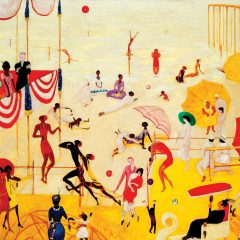We live at a time of unprecedented memoir-izing where people tell all, or as much as they want to reveal (often lots more than a reader wants to know). Here are two memoirs that have either direct or indirect relationships with the art world.
Chief curator at the Michener Museum of Art, Brian Peterson is also an artist in his own right and a published critic. What this book — a compendium of essays, musings, anecdotes and diaristic narrative — reveals is that Peterson is a romantic soul, a poetic wordsmith and someone whose spirituality is a driving force in his worldview. Many pages about God and the Bible notwithstanding, the book is a pleasure to read.
Unlike in many memoirs, few psycho-bombshells are exposed in this relatively ordinary examined life. But Peterson’s inner musings take you on a roller coaster ride. From his discovery of Walt Whitman’s poetry on a cross-country bus ride when he was a teenager to musings on death, regeneration, family — all told through vivid and personal anecdotes with a breezy flow of words — the book is a page-turner. Peterson is a master of mood and description.
The tales and essays are supplemented with a goodly number of pictures, like the nice full page color image of Thomas Eakins’ portrait of Walt Whitman that accompanies the tale of the teenage bus rider discovering Whitman’s poems. Some of the illustrations accompany the essays Peterson wrote about artists he’s worked with. There’s a nice section about photographer Emmett Gowin, for example. And the choice to put Gowin’s photo of the little girl with her twisted arms on the book’s cover is a a great stroke merging inside and out. Both the wonder of that strange image and the sense of wonder and inner contentment on the child’s face capture something of the spirit of the book, If that child is full of easy self-exposure, aw shucks happiness and genuine awe at the world then so is Peterson.

Peterson grew up in Montana with a geologist father, and his grounding in a rural community close to the land and nature pervades the book, from his musings by the banks of the Wissahickon to his sensual pleasure in lying on the grass at night looking up at the stars over Montana. There are stories about a difficult mother, a troubled youth, and health issues with his wife and himself that make him feel his mortality. For its honest examination of self and the world and for its embrace of artistic wonder, the book is a gift. It is a smile to read it.
The Smile at the Heart of Things: Essays and Life Stories
Co-published by Tell Me Press and the James A. Michener Art Museum
ISBN-13: 978-0-9816453-3-9
Nonfiction/hardcover limited edition $28.95 (US)
248 pages, 47 black-and-white and full-color photos
Postmortem is in the “Mommy Dearest” genre of family horror stories told from a child’s point of view. The main characters are Anne Ford, a promising 60s era fashion designer who lives on the fringes of the hot LA art scene, and her daughter Laurel, aka Lolly. Ford is a beauty pageant winner and a model who’s the girlfriend of artist John Altoon. Altoon is part of the Ferus Gallery circle, and Ford, even when she’s married to someone else, goes to openings; participates in Happenings and hosts all-night parties at her own house. Ford is fragile emotionally, a paranoid self-loathing wreck who is destroyed ultimately by alcohol, although her pushy, judgmental and withholding parents seem to have broken her spirit very early on.
This book by Ford’s daughter Lolly (Laurel Saville) is hard reading with its no-holds-barred descriptions of her mother’s death spiral. You feel the child’s anger, fear and impotence against the situation and you marvel that she grew up at all. (There are two brothers, both of them small characters and a father who is remote geographically and emotionally and whose lack of financial support contributes to the continuing stress in the household.
Lolly immerses you in Los Angeles and in the different California-style houses they lived in, and the descriptions bring the time and places to life so vividly you can feel the heat and hear the wind in the trees. In fact Saville’s writing is beautifully descriptive throughout and the book has a cinematic pacing which intersperses scenes from the remembered childhood with those in which Lolly is doing detective work about her mother and discovering pieces of the complex life before it fell apart.

Far from the most dramatic scene in the book but one I enjoyed a lot is the scene near the end of her mother’s life in which Lolly, now in college in New York, visits her mother and asks her to paint her portrait in watercolors. Mother, who can only hold it together for an hour at a time now, somehow finds paper, brushes and paints in the chaos of her house and sits for as long as she can concentrating on the job of portraying her daughter. Finally, she breaks off in frustration unable to continue, but there was bliss in her few moments of concentration and work. The lesson about work and focus as a kind of salvation seems truly the lesson of the book. All work and no play makes Jack a dull boy but all play and no work kills.
Postmortem, by Laurel Saville, 2009 softcover, 196 pages. $16.95 Published at iUniverse











